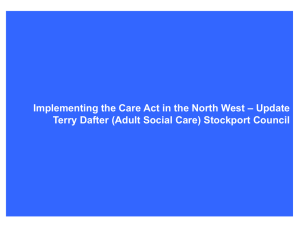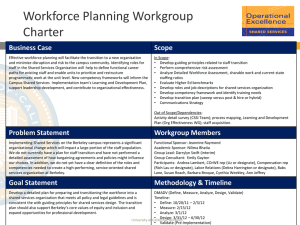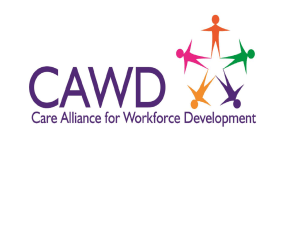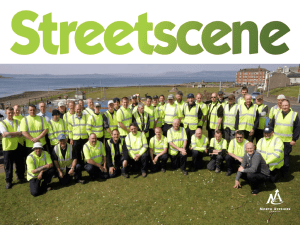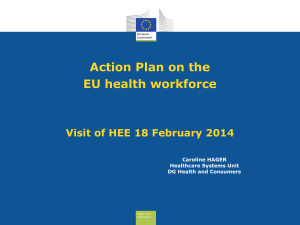Hennepin County Workforce Leadership Council
advertisement
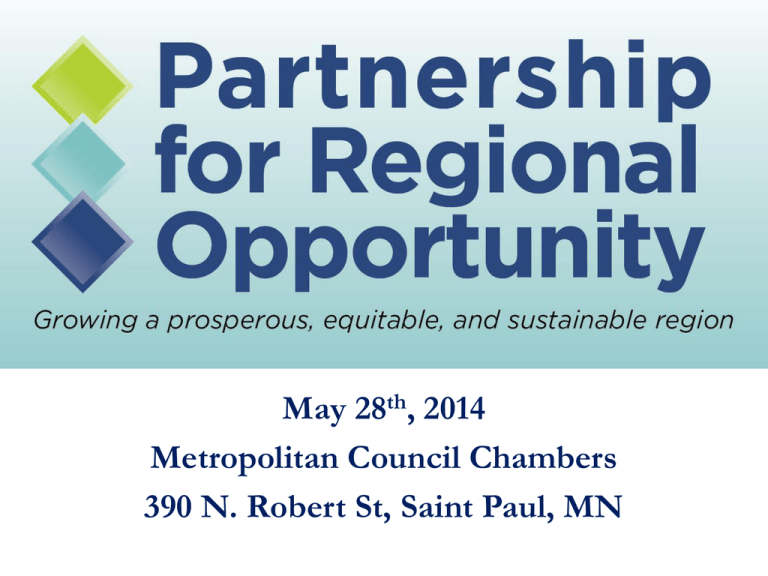
May 28th, 2014 Metropolitan Council Chambers 390 N. Robert St, Saint Paul, MN Hennepin County Workforce Development Education to Employment Program May 28, 2014 Workforce Challenges Aging Workforce - Estimated Retirements through 2020 Total Senior Managers Estimated Retirements % of Workforce 28 20 71% Managers 329 138 43% Supervisors 777 319 42% Employees 5,930 1,761 30% Total 7,064 2,238 32% Source: Hennepin County Human Resources, March 2013. 3 Workforce Challenges Aging Workforce - Estimated Retirements through 2020 Lines of Business Total Employees Estimated Retirements % of Line of Business Operations 1,367 557 41% Human Services 2,737 949 35% Health 367 85 23% Public Works 614 186 30% Public Safety Partners* 1,979 461 23% Total 7,064 2,238 32% * Includes Sheriff’s Office, County Attorney’s Office, Department of Community Corrections and Rehabilitation, and Emergency Management; does not include District Court and Public Defender. Source: Hennepin County Human Resources, March 2013. 4 Sector- Based Job Opportunities* Employment Vacancies Job Classification Vacancies Public Service Assistant Attrition Rate: 8-10% each year Estimated Retirement: 32% through 2020** Minnesota labor force growth is projected to slow from 0.5% in 2013 to 0.1% in 2020, resulting in a workforce shortage. *** Information Technology Specialist Librarian Financial Case Aide Human Services Representative Case Management Assistant Child Support Services Officer Social Worker Community Health Worker Registered Nurse Office Specialist Engineering Technician * Specialized Training Opportunities ** Source: Estimated Retirements. Hennepin County Department of Human Resources, March 2013. *** Source: Minnesota Demographic Center, December 2013. Planning Analyst Probation Officer Corrections Officer 5 Workforce Challenges Unemployment Unemployment Rate: National, State and County Level 8% 7% 7% 6% 5% 4.7% 4.6% Minnesota Hennepin County 4% 3% 2% 1% 0% United States 6 Source: Minnesota Department of Employment and Economic Development, January 2014. Workforce Challenges Unemployment Disparities Hennepin County Unemployment Rate by Race and Ethnicity 25% 21% 20% 17% 15% 10% 8% 7% Asian Hispanic 5% 5% 0% African-American White non-Hispanic American Indian 7 Source: U.S. Bureau of Labor Statistics, 2010. Workforce Challenges Demographic Projections Minneapolis-St. Paul Population by Race and Ethnicity, 2010-2040. 4,000,000 3,500,000 3,000,000 2,500,000 Hispanic 2,000,000 Asian and Other 1,500,000 African-American White non-Hispanic 1,000,000 500,000 0 2010 2020 2030 2040 Source: What Lies Ahead: Population, Household and Employment Forecasts to 2040, Metropolitan Council, April 2012. 8 Hennepin County Workforce Challenges Alignment and Coordination of Workforce Programs 65+ programs and initiatives 40+ external partners Workforce coordinator position 9 Hennepin County Workforce and Employment Development Activities (Internal and External) Hennepin County Board County Administration Educational and Research Partners - University of Minnesota MCTC Summit Academy Itasca Project PPL Better Futures NCRT Foundation Collaboration Operations Genesys Works Program Library - Hennepin County Adult Learning - Franklin Learning Center - Job and Small Business Programming - ACF Partnership - Online Job Resources - Skills Training and Assessment Center for Innovation and Excellence - A-GRAD - Hennepin –University Partnership Resident and Real Estate Services - Tax forfeited Properties - Deconstruction Activities Public Affairs - Internal Services Eligibility and Child Support - - Work and Economic Resource Center - Workforce Planning - Workforce Resources Assessment and Case Management - Day Training and Habilitation - Vocational Services Program Veterans’ Services - Leadership Academy Communications Support - Vocational Rehab GI Bill for the 21st Century Minnesota GI Bill Human Resources - Affirmative Action Program SBE Program Workforce Entry Program Prevailing Wage Program - Service Providers - Employment Services MFIP Services Diversionary Work Program - Workforce Investment Network (WIN) - SNAP E and T - FATHER Project Community-Based Services - Government Partners Purchasing and Contract Services Human Services Information Technology - DRAFT 4/3/14 - METP Goodwill Easter Seals HIRED United Way Tree Trust PPL Resource Inc. MNPAVE Eastside Neighborhood Services Takoda Institute of Higher Learning Refugee Employment Services Twin Cities RISE African Community Services American Indian OIC CAPI USA Emerge Hmong American Partnerships Jewish Family and Children’s Services Lifetrack Resources Lutheran Social Services Perspectives Inc. MN DEED St. Stephen’s RISE Inc. - Public Works Public Health Housing, Community Works and Transit HealthWorks Public Health Nurse Training - ⁻ ⁻ ⁻ ⁻ - - New Provider Types Life Style Overview Surveys Employment Pays Program NorthPoint Health and Wellness NorthPoint Achievement Zone Gateway Project Community Health Worker Northside Workforce Investment Network (WIN) Northside Fresh Economic Work Team Computer Lab/Job Club Employment Counselors Health – Workforce Training Models Employee Training and Certifications Medical Examiner Medical Student Rotation Fellowship Program - Hennepin County Workforce Centers STS Homes/Summit Training Program Community Works - - - Community Works Contracting Adult - Work/Study Release Program - Sentencing to Serve - Productive Day Enterprises - Industries Program Juvenile - Juvenile Detention Alternatives Initiative - Sentencing to Serve - County Home School Programs Environmental Services - - Public Safety Partners Health Hennepin Health - Internships (Step-Up, SCOPE) Recruitment Workforce Planning Leadership Development Knowledge Transfer Training Onboarding MN Dept. of Employment and Economic Development MN Dept. of Human Services Minnesota Workforce Centers Workforce Investment Boards (Hennepin-Carver and Minneapolis) City of Minneapolis (CPED, METP) Other city partners County Attorney Recycling Contracts (PPL/Better Futures) Deconstruction Activities - - Prevailing Wage Program Internships Community Partners - Sheriff’s Office - Internships Citizen Academy Diversity Recruitment : Hennepin County Government : External Entities - PPL Summit Academy HIRED Twin Cities RISE Emerge Workforce YouthLink Employment Action Center American Indian OIC Northside Achievement Zone Greater MSP Better Futures Habitat GMHC Downtown Council United Way Urban League “100 Hard Hats” Consortium African Community Services CAPI USA Jewish Family and Children’s Services Eastside Neighborhood Services Goodwill Easter Seals Hmong American Partnerships Lifetrack Resources Lutheran Social Services Perspectives Inc. Resource Inc. St. Stephen’s RISE Inc. 10 Hennepin County and External Workforce Entities MN DEED Workforce Investment Boards Other Municipalities Federal City of Minneapolis State/Region Local Cities Minnesota Workforce Centers Hennepin County Service Providers (i.e., Twin Cities RISE) Service Providers (i.e., United Way) Community Partners Private Sector Educational Institutions Community Organizations (i.e., NAZ) County Contracts Research Partners (i.e., Itasca Project) Training Partners (i.e., Summit Academy) : Government Entities : External Organizations Workforce Development Findings Finding Possible Action Minnesota labor force growth is projected to slow from 0.5% in 2013 to 0.1% in 2020, resulting in a workforce shortage. Source: Minnesota Demographic Center, December 2013. By 2018, 70% of job openings will require a credential. (i.e., certifcation, licensure, associate’s degree, bachelor’s degree). How can we position the county to have the right workforce at the right time? • Work with private and non-profit sectors to train and match employees. • Partner with colleges, universities and training programs to develop a strong future workforce. Source: Georgetown University Center on Education and the Workforce, June 2010. 12 Current Workforce Development Efforts Programs Description Hennepin County and MCTC Pathways Partnership Training and pathways into employment Workforce Activities Alignment Creation of workforce coordinator position Workforce Entry Program (WEP) Meeting the demand for skilled trade persons while developing the county’s economic resources by providing unemployed individuals the means to earn a better living. A-GRAD Initiative Improving high school graduation rates Workforce Investment Network Partnerships to create workforce opportunities for targeted communities and reducing economic disparities Step-Up Program High school internships at the county Employment Pays Program Employment supports for individuals with high behavioral health needs NorthPoint/Urban League Training and employment partnership Pilot program to attract professionals (i.e., engineers and scientists) Recruitment and targeted hiring 13 Recommended Workforce Development Strategies Strategy Description Hennepin County Workforce Leadership Council • • • • Vision, strategy and goals Recruit employers and educational partners Support training partnerships Commissioner representation Workforce Master Cooperative Agreement • • Create Hennepin County Workforce Leadership Council Creates the formal vehicle to establish training framework MCTCWorks Pathways Tool • • • Web-based career map Academic program information Live job postings Evaluation of Job Classifications • • Flexibility and best practices Certificates, associate’s or bachelor’s degree Recognizing Education Equivalencies • • Associate’s degree candidates Bachelor’s degree candidates 14 Hennepin County Workforce Leadership Council Membership: Hennepin County Employers Educational Institutions Workforce Investment Boards Function: Purpose: Leadership Governance Policy Partnerships Fundraising Networking Innovation Education and Training Develop sector-based workforce Provide internships and employment opportunities 15 Workforce Master Cooperative Agreement Workforce Leadership Council o Initial Members: Hennepin County, MCTC, MNSCU, Downtown Council, other private and public sector partners Formal framework to establish training o Statements of work for specific job curriculum (i.e., IT, health) o Scholarships o Curriculum development costs o Internships o Employment opportunities 16 Master Cooperative Agreement Structure Hennepin County Workforce Leadership Council Private Sector Public Sector Hennepin County Educational Institutions Sector-Based Education and Training Internships Employment Opportunities 17 Human Services Representative FastTRAC Program: 41 participants 8 ½ month program Education and Training: Project for Pride in Living (PPL) Minneapolis Community and Technical College (MCTC) Internships: Hennepin County Human Services Department Graduation: June 2014 Employment Opportunities: Hennepin County Certification Other counties 18 Evaluation of Job Classifications • Recognizing Educational Equivalencies Job Classification Previous Requirement Revised Requirement Human Services Representative Bachelor’s degree Associate’s degree or FastTRAC program IT Specialist Bachelor’s degree Associate’s degree • Salary by Education Level in Hennepin County High School Diploma Median Associate’s Degree Median 19 Source: Wanted Analytics, March 2014. Next Steps Approve Workforce Master Cooperative Agreement Workforce Leadership Council Creation Statements of work Approve $200,000 contingency transfer (Resolution 13-0316R1) for curriculum development Evaluation of: Job classifications Internship best practices User-friendly job postings 20 May 28th, 2014 Metropolitan Council Chambers 390 N. Robert St, Saint Paul, MN TC3: FUTURES 22 ECONOMIC EQUITY EQUALS (EQ) Mobility/Proximity Central Business District and Access Mass transit accessibility Marketable Skills/Education Short-term (< 2 years) credentialed certification focused on applicable, market-ready skills Relationships/Social Networks Social Capital = critical linkage to skilled employment and economic opportunity 23 MFSA: THE TEST MARKET Developments and Progress Began workforce procurement efforts January 2014 Partnered with Mortenson/Thor and subs to develop workforce projections. Procuring workforce for 10 major trades over life of project, including specialty trades. EAF Update 90 skilled candidates currently available for employment on the project. 54 candidates complete training and ready for project demand June 30th . 38 Specialty Trade training candidates complete training and ready for project demand September 8th. Job Fair yielded 600 candidates 24 THE TC3 SYSTEM DEMAND Jurisdictions FORECAST SUPPLY EAF Owners General and Subcontractors EAF Community Outreach Partners Training Partners Union Partners Functions Functions Forecast Labor Needs Training Cycles Marketing Intake Assessment Training Placement Project I.D. Workforce Need REPORTING Outreach # Enrollment # Graduation # Placement # Retention # Financial Reporting 25 KEY ACCOMPLISHMENTS Establishment of Administrative and Forecasting Protocols and Procedures across agencies (owners, general and subcontractors): TC3 Operations Management Contract Management Data Management and Forecasting EAF Process Management Measurement and Evaluation Establishment of outreach, training, and placement targets to manage and deliver a skilled workforce: Developed recruiting & training targets Developed training schedules Subcontractor agreements with training & outreach partners 26 MOBILIZING THE (UN)SKILLED WORKFORCE Identification & Recruitment of a skilled labor pool 435 Candidates skilled/unskilled in the EAF database 90 skilled workers placement ready. Recruited from job fair. 120 skilled and/or unskilled completing assessments 225 in training and/or training ready 27 COORDINATED ADULT WORKFORCE SYSTEM Outreach Partners Latino Economic Development Council Community Standards Initiative Somali Education & Social Advocacy Center Training Partners 28 SAOIC: BUILDING A CONSTRUCTION WORKFORCE 29 KEY STAKEHOLDERS: TC3 MOMENTUM The outlined jurisdictions below have been engaged in discussions on TC3 and expressed interest to adopt: City of Minneapolis Public Works 300 retirements over the next 5 years Hennepin County Public Works Capital Improvement Plan 2014-2018 $676,694,222 MET Council 2014-2018: $1,082,000,000 Projected SWRT budget between $1.673-$1.683 billion 30 POTENTIAL OPPORTUNITIES… DOWNTOWN EAST Creates 1,000 construction jobs over 24 months Expands full-time employment opportunities in downtown Minneapolis Critical linkage to adjoining neighborhoods and community access NICOLLET CORRIDOR Vertical and horizontal construction development $50 million direct spending 1,000 additional full-time jobs in Downtown Minneapolis post-construction (retail, hospitality, customer service, business administration) 31 IN DOWNTOWN MINNEAPOLIS HCMC $191 million, 322,000 square foot medical clinic and specialty center Opening in 2016 Kraus Anderson HQ 80,000 square foot headquarters in the heart of downtown Minneapolis. $15 million projected costs HQ scheduled to open in 2015 32 MARKET NEED Client Project Value Articulated Need Expected Start MSFA/Mortenson Viking Stadium $1,000,000,000 100 In Progress Ryan Construction Downtown East 650,000,000 x May 2014 – 2016 Hennepin County HCMC $192,000,000 x Dec 2014 – June 2016 City of Minneapolis Target Center $98,000,000 x June 2014 MET Council SWLRT $1,200,000,000 x 2016-2018 City of Minneapolis Nicollet Mall Corridor $50,000,000 x Fall 2015 City of St. Paul Saint Paul Saints Stadium $80,000,000 x April 2014- March 2015 Kraus Anderson Construction Kraus Anderson Headquarters $15,000,000 x October 2014-Oct 2015 33 MIDDLE SCHOOL & HIGH SCHOOL PLATFORM Extra-Curricular Development at Middle School Platform (Harvest Prep Middle School) Ongoing discussion with Minneapolis Public Schools & continue to navigate the political system Identified critical adult education GAP in the community: GED Adult Basic Education BRIDGE STRATEGY: (RE)CONSTRUCT THE GED Challenge: Expand GED population to mobilize workforce Over 40% of the MFIP population in North Minneapolis does not have a GED or High School Diploma. Opportunity: GED Fast Track to Construction Need for fast track Workforce GED Training to address adult education gap to prepare adults for vocational education and training. Opportunity to tailor GED track to meet pre-apprentice training requirements. 34 INFRASTRUCTURE DEVELOPMENT POLICY Market leaders to adopt: Hennepin County City of Minneapolis MET Council Penetrate bureaucracy operating procedures Legislative support State and Local Financing 35 CHALLENGES & OPPORTUNITIES CHALLENGES: Snail pace of bureaucracy Partnership Management CBO patience Outreach capacity Union politics Unity of interests OPPORTUNITIES: $2 billion in construction in Downtown Minneapolis Carlson Consulting Enterprise key findings: Future worker shortages Impact of racism Vertical expansion of EAF 36 NEXT STEPS Secure market leaders: City of Minneapolis Public Works Hennepin County Public Works MET Council Operationalize TC3 Framework Business Plan Customer Expansion Platform for workforce development S3 TC3 serves as the basis for a workforce development system (S3) expanding beyond the construction sector. High growth industries as identified by the U.S. Department of Labor High Growth Job Training Initiative include: Manufacturing, Hospitality, Retail, and Healthcare. 37 May 28th, 2014 Metropolitan Council Chambers 390 N. Robert St, Saint Paul, MN New NDC Logo Here East Metro Job Creation Fund supported by the St. Paul Foundation through a Program Related Investment This means we have to pay it back with interest Who we are? Jan Jordet Mike LaFave Senior Director Consulting & Financing Services Vice President & Chief Operating Officer 612-259-6566 jjordet@meda.net 651-379-8424 mlafave@ndc-mn.org • 43 years old – founded by corporate executives • Vision – thriving communities through equal economic opportunity • Mission - helping entrepreneurs of color succeed! • Core services provide: Access to information/consulting Access to financing Access to government and corporate markets • One-on-one consulting model aimed at bringing minority-owned businesses to scale www.meda.net NDC PAGE • Formed in 1993 • Mission: Empower low income entrepreneurs in specific low income communities as revitalization strategy • Building neighborhood economies from within • People and Place based approach • Core services: – – – – Entrepreneur Training Small Business Lending Technical Assistance/Business coaching Equitable Real Estate Development www.ndc-mn.org Why financing? • Studies from local, regional and national entities have shown: – People of color are more often declined financing with all things being equal – When receiving financing, people of color often receive higher interest rates than white counterparts – Greatest obstacle to business success for MBEs is identified as access to financing East Metro Job Creation Fund Job Creation Each organization received $1 million in capital Business Expansion Business Starts Financing (Technical Assistance) Entrepreneurs are job creators! PRI Terms • Meda and NDC have ten years to deploy the $1 million – different markets/approaches • Goal is to make loans to mid-market businesses in the East Metro with a goal of creating new jobs benefitting low-income residents and giving specific attention to residents of color. Entrepreneurs of color employ more people of color! • Meda’s survey of about 200 companies annually shows that minority-owned business enterprises (MBEs) are more likely to hire other people of color. • Newest survey from 2013 shows that 42% of all MBE employees were people of color. • and 86% were paid a living wage or more! Examples: • Small remodeling construction company - $50,000 for working capital – created 2 jobs ($15/hr) • Small insulation company - $17,500 to secure a bond for union workers – retained 4 jobs ($23/hr) • Newly acquired excavation and sewer company $50,000 equity-like capital - retained 15 jobs ($26/hour) • Expansion of small manufacturer - $175,000 creating 4 jobs ($22/hr) Examples: • Food manufacturing company - $150,000 Equipment Loan - created 15 new jobs retained 20 jobs ($16/hr) • Sheet rock installation company - $100,000 working capital loan; added 3 new permanent jobs/15 temporary jobs ($23/hr) • Small construction company - $50,000 working capital line of credit – created 3 new jobs (15/hr) Access to capital necessary but not sufficient • Technical Assistance is critical! • In each example, NDC and Meda spent numerous hour working 1 on 1 with entrepreneurs to: – Build their capacity – Enhance skills – Connect them to networks – Prepare them to utilize capital effectively – Build sustainable businesses Economic Equity creates thriving communities • Thanks to the St. Paul Foundation for entering this type of philanthropy • McKnight Foundation is also funding a collaborative effort for economic equity in transit oriented development projects • Other private and community foundations are recognizing the power of business ownership • Successful entrepreneurs not only create jobs but build wealth in communities left behind by a history of institutional inequities Questions? Jan Jordet Mike LaFave Senior Director Consulting & Financing Services Vice President & Chief Operating Officer 612-259-6566 jjordet@meda.net 651-379-8424 mlafave@ndc-mn.org May 28th, 2014 Metropolitan Council Chambers 390 N. Robert St, Saint Paul, MN


